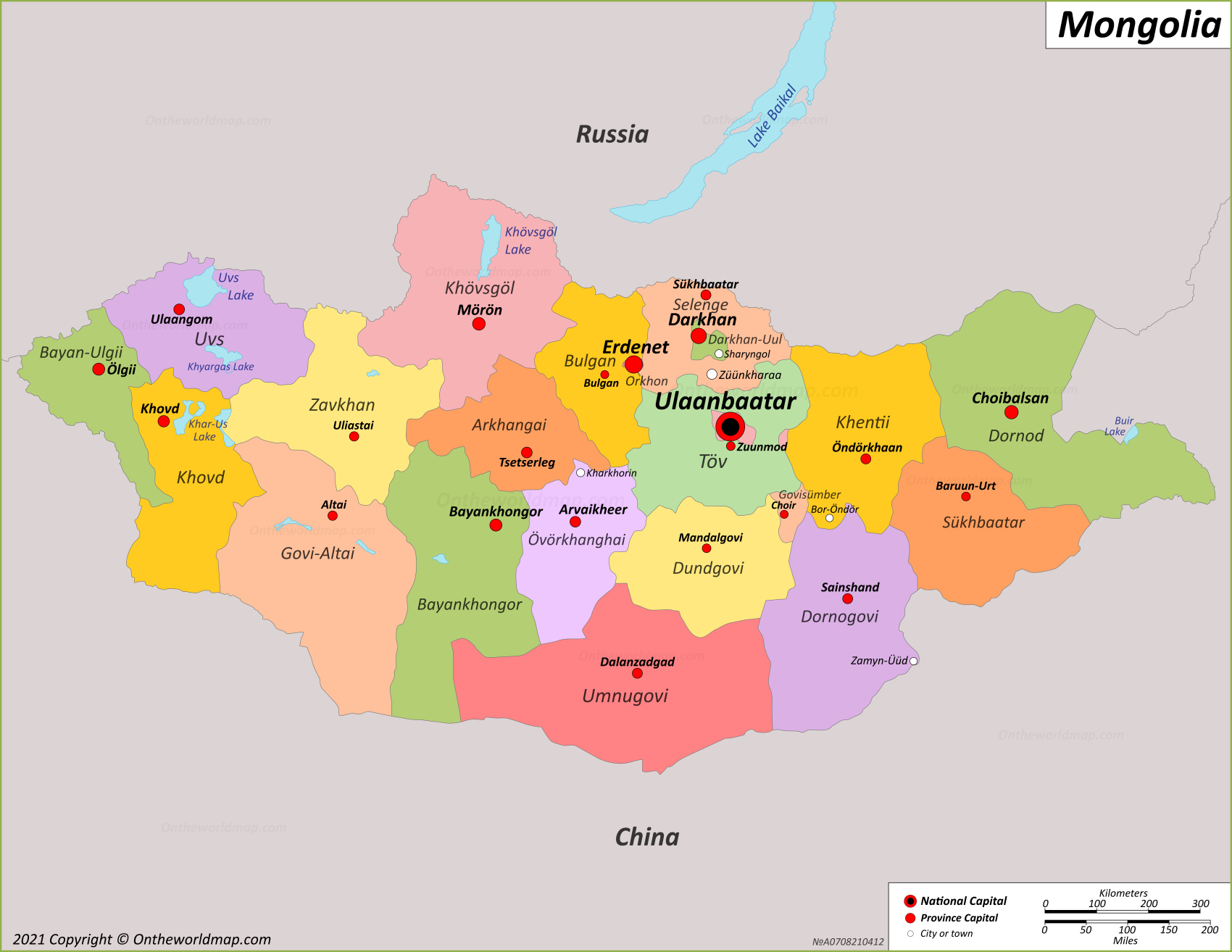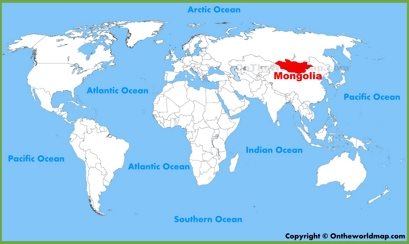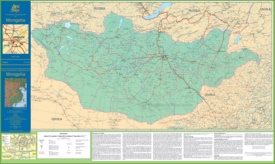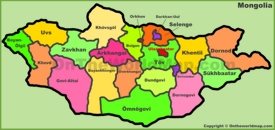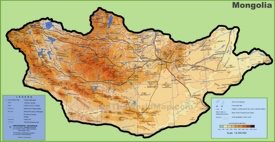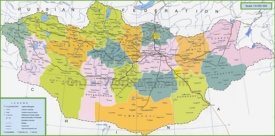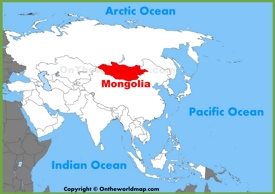Mongolia Map
Description:
This map shows governmental boundaries of countries, province boundaries, provinces, province capital cities, major cities and towns in Mongolia.
Size: 1700x1314px / 468 Kb
Author: Ontheworldmap.com
You may download, print or use the above map for educational, personal and non-commercial purposes. Attribution is required. For any website, blog, scientific research or e-book, you must place a hyperlink (to this page) with an attribution next to the image used.
Online Map of Mongolia
Detailed Maps of Mongolia
About Mongolia
Mongolia is a country in Northeast Asia, bordering Russia to the north and China to the south. The country is landlocked. Most of the country is flat deserts and semi-deserts. Mongolia has an area of 603,909 sq mi (1,564,116 sq km) and is the 19th largest country in the world. The population of Mongolia is about three and a half million people, which along with its large area makes it the least densely populated country in the world. The majority of the population (about 95%) are Khalkha-Mongols. The official language is Khalkha-Mongolian, written in the Cyrillic alphabet.
The capital and largest city is Ulaanbaatar. Other major cities are Erdenet, Darkhan, Choibalsan, Mörön, Nalaikh, and Tsetserlag. Mongolia is divided into 21 aimags, which in turn have 329 somons.
Although more people live in urban areas, Mongolia's economy is centered on industries such as mining and agriculture. Mineral resources such as copper, molybdenum, tin, tungsten, coal, and gold make up a significant portion of the country's industrial production. The country's main trading partners are neighboring China and Russia, and Mongolia's economy is largely dependent on these countries.
Modern Mongolia is undergoing societal shifts as modernization affects urban lifestyles, education, and the introduction of technology. Nevertheless, Mongolians retain a close connection to their heritage, constantly balancing modern advances and traditional practices. Buddhism, has a significant influence on Mongolian culture. Monasteries act as centers of spiritual education and cultural preservation.
The Facts:| Capital: | Ulaanbaatar |
| Area: | 603,909 sq mi (1,564,116 sq km) |
| Population (2023): | ~ 3,504,741[1] |
| Official language: | Mongolian |
| Currency: | Tögrög (MNT) |
| Driving side: | right |
| Calling code: | 976 |
| Internet TLD: | .mn, .мон |
| Time zone: | UTC+7/+8 |
| Gross domestic product 2023 (PPP): |
|
| Gross domestic product 2023 (nominal): |
|
Largest Cities: Ulaanbaatar, Erdenet, Darkhan, Choibalsan, Mörön, Nalaikh, Bayankhongor, Ölgii, Khovd, Arvaikheer, Ulaangom, Baganuur, Sainshand, Tsetserleg, Sükhbaatar, Öndörkhaan, Dalanzadgad, Züünkharaa, Uliastai, Altai, Baruun-Urt, Mandalgovi, Zuunmod, Zamyn-Üüd, Bulgan, Kharkhorin, Choir, Bor-Öndör, Sharyngol.
Provinces (aimags) of Mongolia: Arkhangai, Bayankhongor, Bayan-Ulgii, Bulgan, Darkhan-Uul, Dornod, Dornogovi, Dundgovi, Govi-Altai, Govisümber, Khentii, Khovd, Khövsgöl, Orkhon, Selenge, Sükhbaatar, Töv, Ömnögovi, Uvs, Övörkhanghai, Zavkhan.
Geography of Mongolia
The geography of Mongolia includes vast steppes, deserts and mountain ranges, the highest of which is the Mongolian Altai. The country is 486 mi (1,260 km) from north to south and 927 mi (2,400 km) from west to east. The country has three main regions: the Gobi Desert in the south, vast steppes in the central part, and mountainous areas, including the Altai Range, in the west and north.
The climate in Mongolia is sharply continental, characterized by long, frosty winters with little snow and warm, relatively humid summers with significant temperature variations. Temperatures fall below -30°C (-22°F) in winter and can reach 40°C (104°F) in summer in some areas. An important feature of the climate is the presence of summer monsoon rains. Rainfall is low, especially in the arid south, contributing to the semi-arid conditions prevalent throughout much of the country.
Brief History of Mongolia
Mongolia's history is marked by the rise and fall of mighty empires and enduring nomadic traditions. Genghis Khan founded the Mongol Empire in the early 13th century, uniting the various Mongol tribes and creating one of the largest empires in history. Under his leadership and that of his successors, the empire spread throughout Asia and Eastern Europe.
After the collapse of the empire in the fourteenth century, Mongolia experienced periods of internal division and foreign domination, especially under the Manchu Qing dynasty from the seventeenth to the early twentieth century. Mongolia declared independence in 1911, although full recognition came only after the fall of the Qing dynasty in 1912.
In 1924, the Mongolian People's Republic was established, marking the beginning of Soviet influence and leading to socialist rule and significant social restructuring. After the democratic revolution of 1990, Mongolia transitioned to a multi-party system and a market economy.

